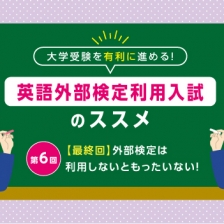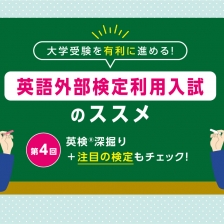3回にわたってお送りしている、「センター試験(英語) :解き方と時間配分」も今回が最後。高得点を目指して頑張りましょう。
前回の記事:【第2回】センター試験(英語):解き方と時間配分
これまで、センター試験 英語(筆記)の問題数と配点の関係や第1問から第5問の解き方の戦略と時間配分の目安について解説してきました。最後の今回は、第6問を取り上げます。
大問ごとの解き方と時間配分の目安(読解系: 第6問)
■ 第6問 説明文(問題数6問、配点36点)
第6問については、少々の変化はあっても、大きな傾向変化はほとんどありません。毎年ほぼ6段楽構成で600語程度の説明文が出題されます。段落構成も以下に示すような「定番のサンドイッチ構造」になっています。
1.提示部 : 第1段落でテーマ・メイントピックを提示
2.展開部 : 第2~5段落でその具体的説明を展開
3.結論(まとめとテーマの再提示): 最後の第6段落は第1段落のテーマ・語彙を繰り返しながら、第2~5段落の内容を手短にまとめる
上記の英文構成を念頭に置いていれば、早く的確な読解が可能です。また、速読のコツとして忘れてならないのは「第1段落をしっかり読む」ことです。それによって、文全体のテーマと展開、主張の輪郭などが分かり、それ以降は、上記の段落構成と合わせて「予測しながら読める」ため、読解スピードは大幅にアップします。
まずは、実際の試験問題を使って、高得点のコツを示します。
★Point 1
各設問の英文に一瞬軽く目を通し「書かれていることの一部」を掴んだ上で、「第1段落をしっかり読む」。
問2“microscopes”、問4“cameras”→第1段落“This change from invisible to visible has led to tremendous growth in our comprehension…
★Point 2
問1~問4は段落ごとに設問が設定されているので、各段落を読んですぐに設問を解く。
全部最後まで読んでから解くと、各段落の内容を忘れてしまい、また初めから各段落を確かめることになり、時間をロスする。逆に「読みたて」なら記憶はフレッシュなので、正解率が上がり、文章理解も進んでさらにテンポが上がる。
★Point 3
問1~問4は各段落の要旨を問う場合が多いので、基本的に各段落の初めに提示される「トピック」と、段落の中盤から後半に示される「トピックがもたらす結果・変化」に着目する。ほとんどの場合、「結果・変化」が正解になる。
「なるほど」と思う内容で、多くの場合、It is important to remember that SV…のように、thatが導く名詞節や、一般常識を引き合いに出して「ところが…」と逆説的に真実を提示する箇所。
★Point 4
問5は第1段落と最終段落に書いてあるテーマ・メイントピック、問6は上記に示したような段落構成なので、まず難問はない。
それでは、実際の試験で、上記の英文構造と解き方のコツを見ていきましょう。
(センター試験 英語(筆記) 平成30年度 第6問)
文章の左にある(1)~(6)はパラグラフ(段落)の番号を表している。
(1) History teaches us that technology and associated discoveries have changed how we understand the world. Many technological devices provide additional range and power to our natural capacities, such as our five senses. Among these devices, many enable us to see things that we cannot see with the naked eye. This change from invisible to visible has led to tremendous growth in our comprehension of the world and has strongly influenced our ways of thinking.
(2) In the 17th century, a scientist noticed that by holding two lenses together in a certain way he could make an object appear larger. He used this technique to construct the first simple telescope. Using these archaic telescopes, early scientists were able to describe the surface of the Moon in detail and to see that Jupiter had at least four such satellites. Since that time, people have developed various devices that expand our range of sight, thus revealing facts about the universe that lies beyond the Earth. The telescope continues to offer us new views concerning things beyond our immediate reach.
(3) Later, the microscope was developed using principles similar to the telescope. The microscope allows us to study objects we normally cannot see because they are too small. Looking through a microscope opened up an entirely new world to scientists. Before the invention of the microscope, they couldn't see the structures of human tissues or cells in plants and animals. When they saw these things, they became aware that some things that they had thought were whole and could not be divided, actually consisted of smaller components. These were only visible with the assistance of microscopes. Today, electron microscopes allow us to investigate even smaller items, such as molecules. These advances have altered our concepts regarding the composition of things in the world.
(4) The invention of the camera also made the invisible world visible. In the world, everything is changing. Some things change faster than we can see. The camera is a tool that gives us the power to freeze change at different points in time. Series of pictures have revealed how birds move in flight and athletes run. The camera can also help us see changes that are so gradual that we usually don't notice them. For example, by comparing photos of the same scene taken months or years apart, we can gain insights into how societies change. There are many other ways besides these in which the camera has changed our perceptions of the world.
(5) In the late 19th century, machines that used the newly discovered X-rays revolutionized the way in which we looked at things. Rather than seeing only the surface of an object, we gained the ability to look into it or through it, bringing the inner elements of many things into our range of view. This capability proved practical in the workplace, useful in laboratories and museums, and instructive in universities. One of the most important applications was in medicine. Doctors often had difficulty diagnosing illnesses or finding problems inside the body. X-rays allowed them to look into their patients, identify where there were problems, and cure them. This use of X-rays brought new understandings and methods for diagnosis and treatment.
(6) Different technological devices have made it possible to observe things that we could not see with the naked eye. This has significantly altered our understandings of the world around us. Each technological advance changes us in unpredictable ways, and each discovery increases our knowledge about the world. Just as the devices mentioned above have done, new devices will continue to impact our lives and change our ways of thinking in the future.
●提示部(テーマ・メイントピック)
第1段落
<theme / main topic>
Technological devices:
→enable us to see / from invisible to visible [=change]
(科学技術による装置→見えないものを見えるようにした [=変化])
This change:
→A. tremendous growth in our comprehension of the world
B. strong influence on our ways of thinking [=big change]
(こうした変化→ A. 世界の包括的理解における大きな進歩 + B. 考え方に対する強い影響 [=大変化])
●展開部(具体的説明)
第2段落
Telescope:
→allow us to study [able to see] →reveal the facts of the universe
第3段落
Microscope:
Before ... microscope = they couldn't see the structure of ...
they had thought ... whole ... not be divided
*変化(発明) [赤字斜体部分]
→When they saw these things
(=able to see the structures of ...)
*変化(事実認識) [太字下線部分]
→become aware that things consist of smaller components
第4段落
Camera:
→power to freeze change [=able to see] →change our perception of the world
第5段落
X-rays:
→able to look into →identify where there're problems and cure them / new understandings and methods for diagnosis and treatment
●結論(まとめとテーマの再提示)
第6段落
Different technological devices →possible to observe →increase our knowledge
80分中、第1問は2分~3分、第2問は10分~15分、第3問は14分~16分、第4問は13分~15分、第5問は約10分と上手に時間配分し、第6問と最後の見直しなどには20分~30分程度の時間を使えるようにしましょう!
このように、英文全体を見渡しながら、各設問のポイントを押さえていけば「速読+高得点」はさほど難しくありません。ただし、これが本当にできるようになるには十分な語彙力が必要になります。この点も忘れずにラストスパートを頑張ってください。
※センター試験 英語(筆記)平成30年度本試験の問題および過去の試験問題は、大学入試センターのウェブサイトよりご覧いただけます。
おすすめ記事
-

2024/09/13
- 第6回(最終回) 外部検定は利用しないともったいない!
- これまで5回にわたって英語や漢字、数学などの外部検定利用入試についてお伝えしてきましたが、いよいよ最終回です。これまでチェックしてきたポイントをもう一度振り返りながら、外部検定を活用するメリットをまとめてみます。
大学受験を有利に進める!英語外部検定利用入試のススメ
-

2024/08/14
- 【第5回】一般選抜でも外部検定を活用してみよう!
- 前回は、英検®について詳しくチェックしたほか、最近注目の検定にも触れました。この時期は、総合型選抜・学校推薦型選抜の準備が終わって、あとは出願と試験を受けるだけという人も多いのでは? でも、もしものことを考えて、今から一般選抜も準備しておいた方が安心です。今回は一般選抜について外部検定の活用も含めて詳しく見ていきましょう。
大学受験を有利に進める!英語外部検定利用入試のススメ
-

2024/07/12
- 【第4回】英検®深掘り+注目の検定もチェック!
- 第3回記事では、英語外部検定をはじめとする各種検定のオススメをご紹介しました。なかでも「英検®」の準2級・2級が狙い目とお伝えしました。今回はさらにこの「英検®」について深掘りしていきます。加えて、最近注目の英語外部検定であるTEAP®やIELTS ™、コンピューターを使った検定「漢検CBT」についても見ていきましょう。
大学受験を有利に進める!英語外部検定利用入試のススメ


